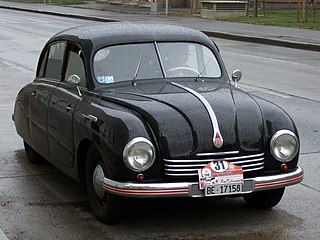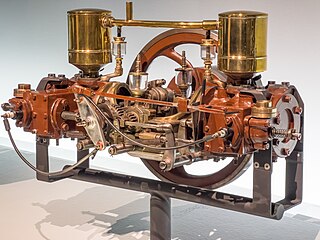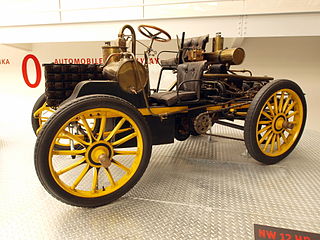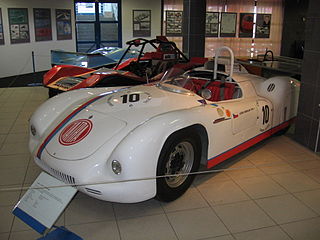Trabant is a series of small cars produced from 1957 until 1991 by former East German car manufacturer VEB Sachsenring Automobilwerke Zwickau. Four models were made: the Trabant 500, Trabant 600, Trabant 601, and the Trabant 1.1. The first model, the 500, was a relatively modern car when it was introduced.

The Tatra 600, named the Tatraplan, was a rear-engined large family car produced from 1948 to 1952 by the Czech manufacturer Tatra. The first prototype was finished in 1946.

Tatra is a Czech vehicle manufacturer from Kopřivnice. It is owned by the TATRA TRUCKS a.s. company, and it is the third oldest company in the world producing motor vehicles with an unbroken history. The company was founded in 1850 as Ignatz Schustala & Cie. In 1890 the company became a joint-stock company and was renamed the Nesselsdorfer Wagenbau-Fabriksgesellschaft. In 1897, the Nesselsdorfer Wagenbau-Fabriksgesellschaft produced the Präsident, which was the first factory-produced automobile with a petrol engine to be made in Central and Eastern Europe. In 1918, the company was renamed Kopřivnická vozovka a.s., and in 1919 it changed from the Nesselsdorfer marque to the Tatra badge, named after the nearby Tatra Mountains on the Czechoslovak-Polish border.

A flat engine is a piston engine where the cylinders are located on either side of a central crankshaft. Flat engines are also known as horizontally opposed engines, however this is distinct from the less common opposed-piston engine design, whereby each cylinder has two pistons sharing a central combustion chamber.

The Saab Granturismo was a series of up-powered sedans sold by Saab Automobile AB from 1958 to 1968. They were powered by three-cylinder, two-stroke engines until the 1967 model year. Most variants were distinguished from the standard model by twin metal stripes along the rocker panels.

The Chevrolet Celebrity is a front-drive, mid-size passenger car line, manufactured and marketed by Chevrolet for model years 1982-1990, over a single generation.

The Chevrolet Monte Carlo is a two-door coupe that was manufactured and marketed by the Chevrolet division of General Motors. Deriving its name from the city in Monaco, the Monte Carlo was marketed as the first personal luxury car of the Chevrolet brand. Introduced for the 1970 model year, the model line was produced across six generations through the 2008 model year, with a hiatus from 1989 until 1994. The Monte Carlo was a variant of the Pontiac Grand Prix throughout its production.

The Alfa Romeo Alfasud is a small family car manufactured and marketed from 1971 to 1989 by Alfa Romeo as a front-engine, four-door, five-passenger entry-level model over a single generation — with facelifts in 1977 and 1980. There was also a two-door sedan, only available in "ti" trim. Alfa Romeo subsequently introduced a three-door wagon variant, the Giardinetta (1975); two-door coupé, the Alfasud Sprint (1976); three-door hatchback (1981) and finally the five-door hatchback (1982).

The Alpine A110 is a sports car produced by French automobile manufacturer Alpine from 1963 to 1977. The car was styled as a "berlinette", which in the post-WWII era refers to a small enclosed two-door berline, better-known as a coupé. The Alpine A110 succeeded the earlier A108. The car was powered by a succession of Renault engines. A car also named Alpine A110 was introduced in 2017.

The Tatra 77 (T77) is one of the first serial-produced, truly aerodynamically-designed automobiles, produced by Czechoslovakian company Tatra from 1934 to 1938. It was developed by Hans Ledwinka and Paul Jaray, the Zeppelin aerodynamic engineer. Launched in 1934, the Tatra 77 is a coach-built automobile, constructed on a platform chassis with a pressed box-section steel backbone rather than Tatra's trademark tubular chassis, and is powered by a 60 horsepower (45 kW) rear-mounted 2.97-litre air-cooled V8 engine, in later series increased to a 75 horsepower (56 kW) 3.4-litre engine. It possessed advanced engineering features, such as overhead valves, hemispherical combustion chambers, a dry sump, fully independent suspension, rear swing axles and extensive use of lightweight magnesium alloy for the engine, transmission, suspension and body. The average drag coefficient of a 1:5 model of Tatra 77 was recorded as 0.2455. The later model T77a, introduced in 1935, has a top speed of over 150 km/h (93 mph) due to its advanced aerodynamic design which delivers an exceptionally low drag coefficient of 0.212, although some sources claim that this is the coefficient of a 1:5 scale model, not of the car itself. Recent article confirmed the Tatra 77/77a drag coefficient for real full-size car as 0.36.

The Tatra 613 is a large luxury rear wheel driven car with rear-mounted air-cooled engine manufactured by Czechoslovak manufacturer Tatra from 1974 until 1996 as a replacement for the Tatra 603 series.

The Tatra 87 (T87) is a car built by Czechoslovak manufacturer Tatra. It was powered by a rear-mounted 2.9-litre air-cooled 90-degree overhead cam V8 engine that produced 85 horsepower and could drive the car at nearly 100 mph (160 km/h). It is ranked among the fastest production cars of its time. Competing cars in this class, however, used engines with almost twice the displacement, and with fuel consumption of 20 liters per 100 km. Thanks to its aerodynamic shape, the Tatra 87 had a consumption of just 12.5 litres per 100 km. After the war between 1950 and 1953, T87s were fitted with more-modern 2.5-litre V8 T603 engines.

The Tatra 97 (T97) is a Czechoslovak mid-size car built by Tatra in Kopřivnice, Moravia, from 1936 to 1939.

The Tatra 603 is a large rear-engined luxury car which was produced by the Czechoslovak company Tatra from 1956 to 1975. It was a continuation of the series of Tatra streamlined sedans which began with the Tatra 77. In Socialist Czechoslovakia, only high-ranking party officials and heads of factories were driven in 603s; the car was also exported to a number of other countries.

The Tatra 57 are a series of two-door compact cars, built by Czechoslovakian company Tatra from 1932. They are popularly known by the nickname "Hadimrška".

The Tatra 12 is an automobile produced by Czech manufacturer Tatra between 1926 and 1933. It was replaced by the Tatra 57 in 1932.

The Double Racer is a race car manufactured by the Nesselsdorfer Wagenbau-Fabriksgesellschaft (NW), now Tatra, in 1900. It is sometimes also called First Racing, 12 HP, or Race Car. It was commissioned by Baron Theodor von Liebieg. Hans Ledwinka, the man behind the famous rear-engined Tatras, and at the time only 20 years old, helped in the production of the car. The car was designed and built in a five week period in April and May 1900. The Rennzweier was the first car designed specifically for racing to be built in Central Europe.

The Präsident was an automobile manufactured by the Nesselsdorfer Wagenbau-Fabriks-Gesellschaft, now Tatra, in 1897. It was the first practical, factory-produced petrol engine automobile built in Central and Eastern Europe. It was constructed by Leopold Sviták and Hans Ledwinka. The automobile was more of a carriage without horses than a car in modern sense. The car is steered via handlebars. The wooden bodywork is placed on an iron frame. It has four seats and a convertible top that would cover only the rear seats. Both axles have suspension of semi-elliptical leaf springs. The wheels were similar to the ones of a horse carriage, but had rubber tyres. The car had a two cylinder spark ignition Benz engine placed by the rear axle.

The Škoda Popular is a small family car that was made in Czechoslovakia by Škoda from 1933 to 1946. It was the company's most affordable car at the time.

The Tatra 602 Tatraplan Sport is a racing car produced by Tatra in 1949.



















